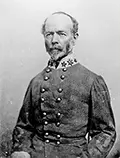Confederate General Joseph Johnston
Joseph Johnston was a Confederate general during the American Civil War. He was the highest-ranking member of the U.S. Army to resign and join the Confederacy. 
He was born on Feb. 3, 1807, in Farmville, Va. He enrolled in the U.S. Military Academy in 1825 and graduated four years later as a second lieutenant, in the 4th U.S. Artillery. He resigned from the Army in 1837 but served aboard a military ship during the Second Seminole War; he was a civilian topographic engineer and sustained a scalp injury from a bullet. He went to Texas in 1841 and was part of the Texas-Mexico border survey. In 1845, he married Lydia McLane; they had no children. He fought in the Mexican-American War, serving with Maj. Gen. Winfield Scott in the march on Mexico City. He was twice wounded and earned a promotion to the rank of lieutenant colonel. After that war, he served in the Department of Texas, as chief topographical engineer. He wrote several letters to then-Secretary of War Jefferson Davis, seeking a command position. Johnson finally granted this request in 1855, appointing Johnston head of the 1st U.S. Cavalry, stationed at Fort Leavenworth, Kan. He helped to stem the violence sustained in "Bleeding Kansas." In 1860, he was named Quartermaster General of the U.S. Army. Johnston resigned his commission when the Civil War began and entered the Confederate Army as a brigadier general. He achieved the rank of general in August 1861. 
Johnston commanded troops at several of the Confederacy's iconic battles during the war. He arrived at Bull Run in 1861 in time to participate in the Confederate rout there. He was promoted to the rank of full general. Also during this time, he helped design the Confederate battle flag. Johnson and his men of the Army of the Northern Virginia moved to block the advance of the Union's Army of the Potomac, which was unfolding its Peninsula Campaign. Johnston's men won a halting action at Seven Pines on May 31, 1862; in this battle, Johnson sustained a severe injury in his chest and shoulder. He gave command of his army to Robert E. Lee. Next serving as commander of the Department of the West, Johnston oversaw the Confederate efforts to keep Tennessee and Mississippi from Union hands. Efforts to raise the Union siege of Vicksburg were unsuccessful, and that city fell to the Union on July 4, 1863. Jackson and Chattanooga followed soon afterward. After the defeat at the latter, Johnston replaced Braxton Bragg as the commander of the Army of Tennessee. 
Johnston directed his troops to set up a defensive network in Dalton, Ga., in order to block William T. Sherman's advance to Atlanta. Sherman steered his army around the town and continued on toward Atlanta. Johnston moved to intercept. This set of actions continued for a time, and the two forces clashed in a large battle at Kennesaw Mountain on June 27. After that defeat, Sherman again moved around the Confederate flank and Johnston again moved to intercept. By this time, Confederate President Jefferson Davis had decided that he wanted a more active commander in that part of the war and so replaced Johnston with Gen. John Bell Hood. Hood, known for his aggressive tactics, took the fight to the Union but lost a series of battles and, ultimately, Atlanta, to Sherman. Johnston gained a new appointment in 1865, heading up two departments in the Deep South. His troops fought Sherman's troops at the Battle of Bentonville, in Georgia, but had to withdraw. When Robert E. Lee surrendered his troops to Ulysses S. Grant on April 9, Johnston entered into surrender talks with Sherman. That surrender came on April 26. Johnston went into business in Savannah, Ga., after the war, in the insurance and railroad industries. He moved back to Virginia in 1877 and won election to the U.S. House of Representatives as a member of the Democratic Party. He served one term and also was commissioner of railroads. Johnston served as a pallbearer at Sherman's funeral. In the pouring rain, Johnston wore no hat, as a sign of respect for his onetime adversary. He caught pneumonia and died two months after the funeral, on March 21, 1891, in Washington, D.C. He was 84. |
|
Social Studies for Kids
copyright 2002–2024
David White




